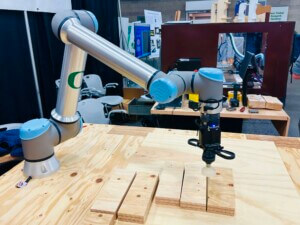Word is out that downtown Portland, Oregon, has its first parklet. Designed by a team of Portland State University architecture students and led by assistant architecture professor B. D. Wortham-Galvin, the 41-foot-long public park covers two parking spaces and opened in June on Southwest 4th Avenue.
Made out of juniper, reclaimed materials, and powder-coated steel, the small space provides ample seating and jaunty bent-metal tables for patrons of nearby eateries and food trucks—or any other member of the public who needs a place to sit a spell.
The project is a collaboration between SoMa EcoDistrict, PSU School of Architecture, Sustainability Neighborhoods Initiative, and the Institute for Sustainable Solutions. While it is the neighborhood’s first public parklet, it’s not, however, the city’s first parklet. In 2012, the Portland Bureau of Transportation, following the models of San Francisco and New York, embarked on the pilot Street Seats program that allows businesses or non-profit organizations to convert on-street parking into a public micro-park.
The parklet offers important transparency into the time and labor that is required for tactical urbanism projects to go from design to permitting to realization. The PSU students began design development as part of a Fall 2013 studio, the city permitted the structure in late 2014, and the ribbon cutting was on June 1. Portland Monthly reported that the design-build project required 1,650 hours of work over the course of 18 months.
The team raised more that $15,000 in crowd-funding and in-kind donations to offset the cost of construction and lost city revenue from paid parking. Covering that revenue is pivotal to the parklet’s lifespan and ultimate impact on the urban fabric.
“When people ask if it is permanent, we have fundraised to build it and to pay the lost revenue for the next year,” Wortham-Galvin told the PSU Vanguard. “Whether it stays or not has nothing to do with permanence, but obviously at some point someone will have to take the initiative to keep paying the lost revenue for the city.”
She told AN that the next phase of the project is just beginning: a post-occupancy study conducted by the students. They’re interested in how the materials hold up and how the parklet is used during the whole day, not just the lunchtime rush. Wortham-Galvin suggested that an important metric is increased public will, or how one public amenity creates demand for more.










